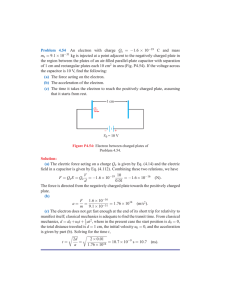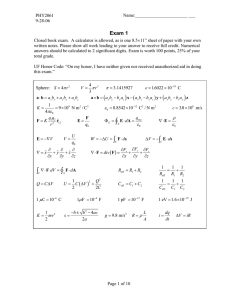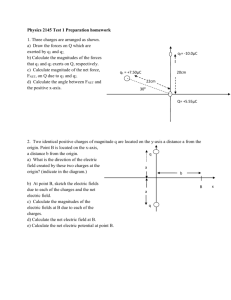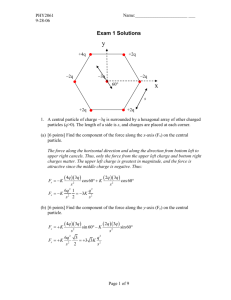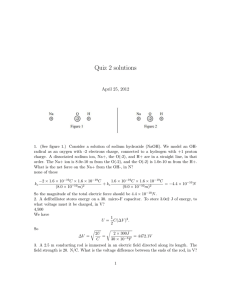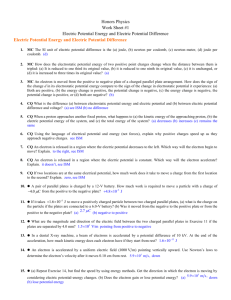POTENTIAL 1. A uniform electric field with a magnitude of 500 N/C is
advertisement
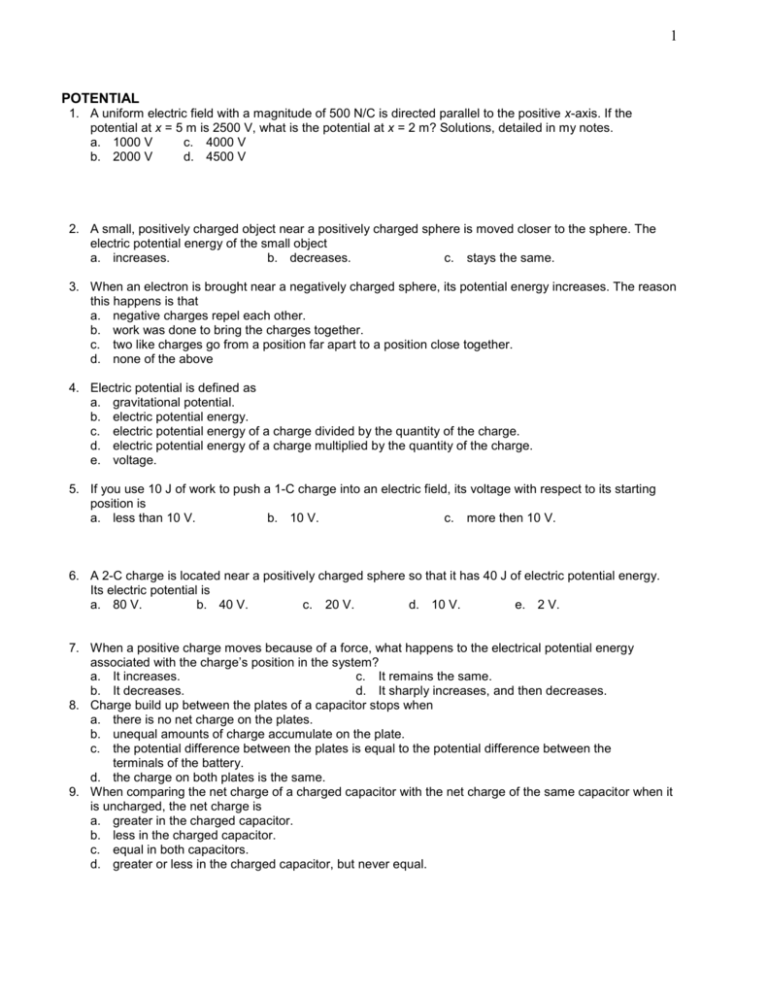
1 POTENTIAL 1. A uniform electric field with a magnitude of 500 N/C is directed parallel to the positive x-axis. If the potential at x = 5 m is 2500 V, what is the potential at x = 2 m? Solutions, detailed in my notes. a. 1000 V c. 4000 V b. 2000 V d. 4500 V 2. A small, positively charged object near a positively charged sphere is moved closer to the sphere. The electric potential energy of the small object a. increases. b. decreases. c. stays the same. 3. When an electron is brought near a negatively charged sphere, its potential energy increases. The reason this happens is that a. negative charges repel each other. b. work was done to bring the charges together. c. two like charges go from a position far apart to a position close together. d. none of the above 4. Electric potential is defined as a. gravitational potential. b. electric potential energy. c. electric potential energy of a charge divided by the quantity of the charge. d. electric potential energy of a charge multiplied by the quantity of the charge. e. voltage. 5. If you use 10 J of work to push a 1-C charge into an electric field, its voltage with respect to its starting position is a. less than 10 V. b. 10 V. c. more then 10 V. 6. A 2-C charge is located near a positively charged sphere so that it has 40 J of electric potential energy. Its electric potential is a. 80 V. b. 40 V. c. 20 V. d. 10 V. e. 2 V. 7. When a positive charge moves because of a force, what happens to the electrical potential energy associated with the charge’s position in the system? a. It increases. c. It remains the same. b. It decreases. d. It sharply increases, and then decreases. 8. Charge build up between the plates of a capacitor stops when a. there is no net charge on the plates. b. unequal amounts of charge accumulate on the plate. c. the potential difference between the plates is equal to the potential difference between the terminals of the battery. d. the charge on both plates is the same. 9. When comparing the net charge of a charged capacitor with the net charge of the same capacitor when it is uncharged, the net charge is a. greater in the charged capacitor. b. less in the charged capacitor. c. equal in both capacitors. d. greater or less in the charged capacitor, but never equal. 2 10.An electron moves from point i to point f, in the direction of a uniform electric field. During this placement: A) the work done by the field is positive and the potential energy of the electron increases B) the work done by the field is negative and the potential energy of the electron increases C) the work done by the field is positive and the potential energy of the electron decreases D) the work done by the field is negative and the potential energy of the electron decreases E) the work done by the field is positive and the potential energy of the electron does not change 11. If 500 J of work are required to carry a 40-C charge from one point to another, the potential difference between these two points is: A) 12.5 V B) 20,000 V C) 0.08 V D) depends on the path E) none of these 12. The potential difference between two points is 100 V. If 2 C is transported from one of these points to the other, the magnitude of the work done is: A) 200 J B) 100 J C) 50 J D) 100 V E) 2J 13. During a lightning discharge, 30 C of charge move through a potential difference of 1.0 × 10 8 V in 2.0 × 10–2 s. The energy released by this lightning bolt is: A) 1.5 × 1011 J B) 3.0 × 109 J C) 6.0 × 107 J D) 3.3 × 106 J E) 1500 J 3 Use the following to answer questions 14-25: The sketch below shows cross sections of equipotential surfaces between two charged conductors that are shown in solid black. Various points on the equipotential surfaces near the conductors are labeled A, B, C, ..., I. 14. At which of the labeled points will the electric field have the greatest magnitude? A) D B)H C)G D)A E)I 15. What is the magnitude of the electric field at point A? A) 100 V/m B) 10 V/m C) 75 V/m D) 25 V/m E) 30 V/m 16. At which of the labeled points will an electron have the greatest potential energy? A) H B)D C)G D)I E)A 17. What is the direction of the electric field at B? A) toward D B) up and out of the page C) into the page D) toward A E) toward C 18. A positive point charge is placed at F. Complete the following statement: When it is released, A) a force will cause it to move toward E. B) it would subsequently lose kinetic energy. C) a force will cause it to move away from E. D) no force will be exerted on it. E) a force will cause it to move toward G. 19. How much work is required to move a 1 C charge from A to E? A) B) C) D) E) 4.0 105 J 7.0 105 J +7.0 105 J zero joules +3.0 105 J 4 20. A point charge gains 50 J of electric potential energy when it is moved from point D to point G. Determine the magnitude of the charge. A) B) C) D) E) 50 C 1.3 C 130 C 25 C 1.0 C 21. What is the potential difference between points B and E? A) 50 V B) 30 V C) 60 V D) 40 V E) 10 V 22. How much work is required to move a 1 C charge from B to D to C? A) B) C) D) E) 4.0 105 J +2.0 105 J +4.0 105 J zero joules 2.0 105 J 23. A charge q = -4.0 µC is moved 0.25 m horizontally to point P in a region where an electric field is 150 V/m and directed vertically as shown. What is the change in the electric potential energy of the charge? A) B) C) D) E) +2.4 103 J 1.5 104 J 2.4 103 J zero joules +1.5 104 J 24. The electric potential at a certain point is space is 12 V. What is the electric potential energy of a -3.0 μC charge placed at that point? A) B) C) D) E) +4 J 4 J 36 J zero µJ +36 J 5 25. A +1.0 μC point charge is moved from point A to B in the uniform electric field as shown. Which one of the following statements is necessarily true concerning the potential energy of the point charge? A) B) C) D) E) It decreases by 6.0 106 J. It increases by 6.0 106J. It decreases by 10.8 106 J. It decreases by 9.0 106 J. It increases by 10.8 106 J. **26. A completely ionized beryllium atom (net charge = +4e) is accelerated through a potential difference of 6.0 V. What is the increase in kinetic energy of the atom? A) 24 eV B) 0.67 eV C) 4 eV D) 6 eV E) zero eV 27. A uniform electric field of 8 V/m exists between the plates of a parallel plate capacitor. How much work is required to move a +20 μC point charge from the negative plate to the positive plate if the plate separation is 0.050 m? A) 8 104 J B) 8 106 J C) 8 105 J D) 1.6 J E) 0.4 J 28. If the work required to move a +0.35 C charge from point A to point B is +125 J, what is the potential difference between the two points? A) 180 V B) 88 V C) zero volts D) 360 V E) 44 V 29. A proton moves in a constant electric field E from point A to point B. The magnitude of the electric field is 4.2 x 10 4 N/C; and it is directed as shown in the drawing, the direction opposite to that of the proton. If the distance from point A to point B is 0.18 m, what is the change in the proton's electric potential energy, UA – UB? A) B) C) D) E) +1.2 x 10–15 J –2.4 x 10–15 J –1.8 x 10–15 J +2.4 x 10–15 J –1.2 x 10–15 J 6 Answer Key 1. C Highly important example A uniform electric field with a magnitude of 500 N/C is directed parallel to the positive x-axis. If the potential at x = 5 m is 2500 V, what is the potential at x = 2 m? Steps how to solve this problem are: a. Drawing a sketch will help a lot: b. Imagine a positive charge q at position x = 5m. c. Force on q due to electric field E is F = qE to the right. d. To move charge from x = 5m position to x = 2m position, one has to exert applied force in the direction against electric field. e. Work done by applied force against electric field will increase electric potential energy of the charge q in electric field E: W = Fapp d cos θ = (cos θ = 1) = qEd = ∆ U f. Use definition for change in potential ∆𝑉 = ∆𝑈 𝑞 = 𝑊 𝑞 = E d = 1500 V g. Potential energy increases to the left (work by applied force) so does potential: V2m = V5m + ∆V = 2500 V + 1500 V = 4000 V h. If there was a positive charge of 2C at position x = 5m, the work W = qEd done on that charge by applied force qE is converted into increase of potential energy: ∆U = W = qEd = 3000 J i. ◊ relationship between uniform electric field E and potential difference between two points distance d from each other along electric field line: ΔV = Ed 2.A 14. E 24.C 3.B → E = ΔV/d 4.C 15. A 5.B 16. A 25.D 6.C and N/C = V/m 7.B 17. A 26.A 8.C 9.C 18. C 27. B 28. D 19. B 29. E 10.B 20. B 11.A 12.A 21.A 13.B 22.D 23.D
